Disclaimer: The information found in this article is provided for educational purposes only and should not be construed as legal advice.
Ploys are simply strategies used by vendors during the negotiation process. These telecom procurement strategies enable vendors to make the most of their position and profit while also minimizing risk. (This risk is shifted onto you, the customer.)
Many vendor ploys are incredibly subtle, making it hard for procurement teams, especially inexperienced ones, to realize when the vendor is utilizing them.
In addition, ploys often appeal to your emotions. They make you feel indebted to the vendor or appreciative of the vendor (and thus, you want to do something nice for the vendor in return, like making a concession).
This is why it’s so critical for your procurement team to familiarize itself with common vendor ploys; that way, the team takes notice when they’re being used and avoids falling for them.
Table of Contents
What Is Telecom Procurement Strategy?
Telecom procurement strategy is the strategy to source the most valuable and cost-efficient vendor for a long time. This strategy is considered for both products and services that need for day-to-day operation. It’s not related to only finding the lowest price; it’s considered to fulfill specific needs, price, quality, customer service, and contract conditions.
28 Telecom Procurement Strategies
Below are 28 telecom procurement strategies that vendors often use to make the deal work in their favor. These are all things for which you should be on the lookout.
To be as prepared as possible for negotiations, always be ready for vendor ploys and communicate them to the entire team so they can respond accordingly. Also, you can learn telecom procurement optimization processes that will be helpful for safeguarding vendor ploys.
Need help combating vendor ploys and employing effective negotiation tactics? Technology Procurement Group’s professional telecom procurement strategy services are here to assist you. For more information, complete the form at the bottom of the page, call us at 1-888-449-1580, or email us at info@TPG-llc.com.
1. Auto-Renew Clauses

Auto-renew clauses are something that you’ll run into frequently because they’re automatically included in most carrier contracts.
However, auto-renew clauses only benefit the carrier; they typically hurt the company working with it. Often, auto-renew clauses have very specific wording that creates a small window in which your company must let the vendor know whether it’s going to renew the contract or not. Otherwise, your company is stuck with a new contract at a high rate. Sometimes, you’ll even be forced into a contract that uses inflated month-to-month rates.
Every company wants to be in control of its contract and to have its options open when the contract comes to a close. It’s best to negotiate auto-renewal language out of the contract completely, if at all possible. Procurement professionals must be sure to thoroughly look through all of the vendor’s terms and conditions to ensure that an auto-renew clause is not hidden in the fine print.
If it’s impossible to remove the auto-renew clause, adding a contract tracking system to the agreement is the best move for you. This means that your company will receive advance notice from the vendor before the contract’s renewal.
2. Multiple or Circuit Commitments
Circuit commitments are multiple individual commitments that expire at different times. They’re difficult to manage because of their variation, and they reduce your company’s leverage.
A single commitment is much preferred to multiple separate commitments, and with a single commitment, it’s much simpler to negotiate rate reviews about halfway through the contract.
3. Inflated Traffic Estimates

It’s best for businesses to provide their own traffic estimates along with their RFPs so that they don’t have to rely on vendors’ estimates.
Relying on vendor estimates most often means relying on heavily inflated figures. Because traffic plays a role in commitment levels, heavily inflated estimates can result in your company having to agree to a larger commitment than necessary, thereby decreasing its leverage.
High commitment levels based on inaccurate traffic estimates are difficult to achieve and can lead to shortfall penalties from vendors.
4. Current Vendor Team Acting Without Approval
Unfortunately, another common vendor telecom procurement strategy that many procurement professionals will encounter is the current vendor team going over their heads.
Your business’s current carrier account rep will frequently reach out to executive management for assistance, and they’ll contact your company’s executive management in turn, rather than engaging with the procurement team. This can undermine your team’s efforts and result in the renewal of a less than satisfactory contract.
5. Delay Tactics

Delay tactics is one of the common vendor telecom procurement strategies used throughout telecommunications procurement, and they’re part of the reason that procurement professionals should budget at least nine to 12 months to get through the entire process.
Delay tactics are common with large incumbent carriers, like AT&T and CenturyLink. Essentially, delay tactics refer to vendors taking their time responding because they know that your company is working with a limited timeframe to agree to a new contract.
Vendors will do whatever they can to continue delaying the process and take up your company’s time. This is why it’s best to include a strict timeline in RFPs that establishes the dates that proposals must be submitted, questions must be asked, and so on.
Delay tactics, or attempting to delay the procurement team and negotiation process for the vendor’s benefit, may look like the vendor bringing up issues at the last minute, right before signing the contract. The vendor knows that your company will be much more accommodating than usual at this point because you’re ready to finish up the process and get the deal done.
Often, vendors use delay tactics in conjunction with another ploy: rushing the customer. The vendor will drag out negotiations and then suddenly require action. Unless your procurement team has an alternative and well-developed backup plan in place, and unless your deadline is flexible, you’ll generally have to give in to the vendor and make unwanted concessions due to this ploy.
Vendors most often employ this strategy in the middle of a deal. The vendor will be very slow to respond, and then, after a stretch of time has passed, it will suddenly rush you and try to force you to take action. Knowing companies’ deadlines is particularly helpful to vendors who are using this ploy.
What can you do to prevent delay tactics from taking over the negotiation process?
The first thing you can do is set aside plenty of time for the procurement process overall, as mentioned above, as well as for competitive bidding and negotiations in particular. Your team can also include a requirement in the RFP stating that vendor proposals must remain valid for a specified period (the standard is 180 days).
Another counter tactic is to use the vendor’s ploy against it; procurement teams can also utilize delay tactics to their advantage. Offering the deal to the vendor close to the end of its fiscal year puts pressure on the vendor to close so the sales rep can obtain SPIFs and other incentives.
6. Reneging
Reneging means that a vendor initially agrees to certain terms, but later goes back on its word. Three main problems result from reneging:
- Reneging further delays the procurement process and takes up more of your company’s time.
- Reneging forces your company to renegotiate with the vendor to try to earn back the terms the vendor originally agreed to.
- Reneging can reduce your company’s vendor options. This is because, often, a company will move forward with a particular vendor based on the terms they’ve both agreed upon, eliminating other vendors in order to do so. Unfortunately, once that vendor reneges, your company is left with fewer choices.
7. Introducing New Commitments Late in Negotiation
Your company and a telecom vendor may have agreed on certain terms, commitments, and fees, but when the contract arrives, you find that the vendor has added in different ones.
This vendor telecom procurement strategy is somewhat similar to reneging, in which the vendor says one thing but then goes back on its word and does something else. Like reneging, introducing new terms late in negotiation results in delays in the procurement process and a need to renegotiate with the vendor.
8. Adverse Terms in Service Guide

Does the vendor contract include URLs? If so, the vendor is likely including potentially adverse terms in what is known as a “Service Guide.” This telecom procurement strategy is often used by vendors in an attempt to slip these terms by your company without you realizing it.
Suppose your company receives a very brief, streamlined contract with only a few terms and conditions spelled out. In that case, it’s extremely likely that the vast majority of the terms and conditions are actually located in the Service Guide.
In some instances, base pricing may also be buried within this web-based document, making it nearly impossible to find. Telecom procurement professionals must be prepared to go through the entire Service Guide to ensure no adverse terms are hidden within it. If you discover terms with which you aren’t in agreement, you’ll need to renegotiate with the vendor.

9. Salespeople Verbally Saying Yes
The unfortunate reality is that many telecom vendor salespeople will simply say “yes” in order to get companies to say “yes.” But verbal communication does not hold the same weight as official communication in writing. A verbal “yes” from a salesperson does not change or override anything written in a contract.
Procurement professionals must ensure all negotiations are recorded in writing and not just verbally. Everything that has been negotiated must be spelled out in the contract.
10. Non-Stabilized Rates

Non-stabilized rates in contracts can increase and change unexpectedly, whereas stabilized rates will remain the same. Be on the lookout for rates that are not stabilized, as they may increase significantly once you’ve signed the contract.
11. Calvo or Staggered Contracts
A Calvo or staggered contract features a pricing model in which the vendor is able to change its rates at any given time, regardless of how long it’s been since the last time it changed its rates. This is obviously extremely beneficial to the vendor, but not to the company it’s working with.
12. The Pop-Tart Ploy
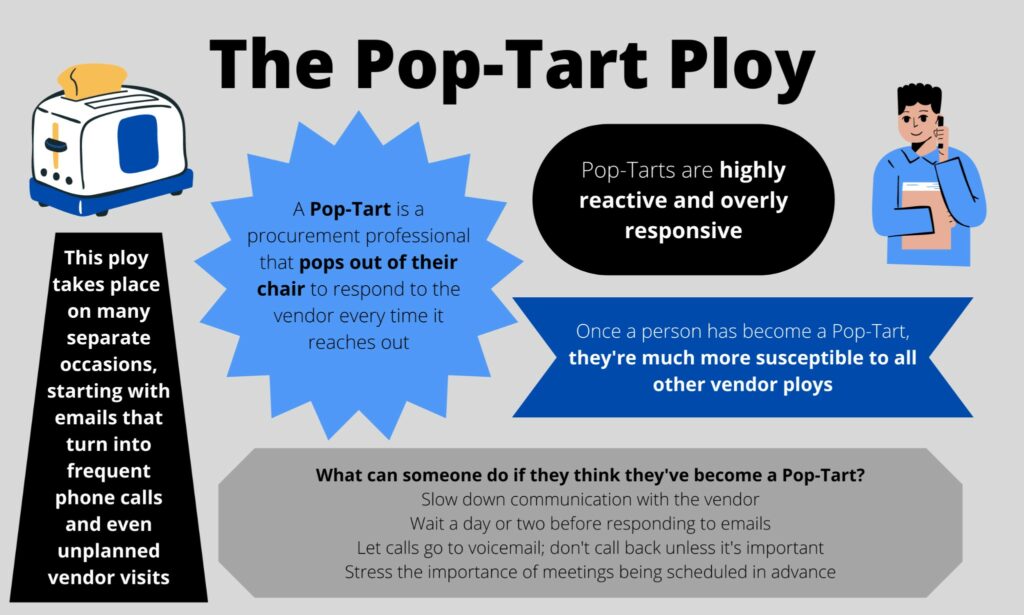
This ploy isn’t so much about what the vendor does; it’s more about the way that you respond to the vendor. A “Pop-Tart” is a customer that essentially “pops” up out of their chair anytime the vendor reaches out.
Pop-Tarts are highly reactive and overly responsive. When they receive an email from the vendor, they answer right away; when the vendor calls, they pick up the phone immediately. If the vendor wants to stop by, they’re only too happy to set aside whatever they’re working on and make time for a meeting.
The reason this ploy is so effective is that workers in the United States are extremely time-pressured. As a result, they become hyper-responsive, wanting to get things done and out of the way as soon as they possibly can. Plus, most people are eager to please in a professional setting. They want the vendor to like them, so they’re more accommodating than they should be.
The problem with being a Pop-Tart is that it makes you extremely susceptible to all other vendor ploys. Once a vendor realizes that you’re highly receptive to all of its communications, it knows that it can successfully use the other strategies it has up its sleeve.
The Pop-Tart Ploy doesn’t occur during a single occasion; instead, it’s spaced out over time. It may begin with emails that start to arrive in your inbox more and more frequently. As you continue to respond quickly, the emails may turn into voicemails that are left on the machine before or after hours, so that you call back as soon as you can during the next business day.
The vendor may begin scheduling rushed meetings and conference calls that must take place ASAP. Scheduled visits may morph into unplanned visits in which the vendor “just stops by” because “they happened to be in the neighborhood” (this is never the case). All of these happenings indicate that you have become a Pop-Tart.
So, if you realize you’ve been labeled a Pop-Tart or think that the vendor is trying to make you into one, is there anything you can do?
The first and most important thing is simply to slow down communication with the vendor. Rather than responding to emails immediately, wait a day or two. If the vendor calls, let it go to voicemail and return it a couple of days later (or don’t call back at all if the call isn’t essential). Don’t allow for unscheduled meetings, and if the vendor wants to schedule a meeting, push it back a few days or even into the following week.
Understand that even though the vendor seems to “need” quick responses and turnaround times, it’s more accurate to say it wants them; remember, time works for the vendor, rather than against it.
13. Catching the Customer Off-Guard

The purpose of this ploy is to surprise you so that you’re unprepared to deal with the vendor. This ploy is never used on its own; instead, the vendor catches you off-guard in order to soften you up for another ploy.
This usually starts with an email or a call from the vendor saying that they’ll be in the area shortly. Often, these communications will arrive at inopportune times, such as during lunch or at the end of the workday, when you’re eating or catching up on your work before heading home. By timing the call or email for these parts of the day, the vendor catches you with your guard down.
The call may start with the vendor saying something along the lines of, “I just wanted to check in and see how you were doing.” Make no mistake, this is not an innocent phone call; it’s a chance to influence you and obtain valuable information that can give the vendor more leverage in negotiations. Vendors that are particularly bold will skip the phone call altogether and simply show up at the office unannounced and totally prepared for a meeting. During this meeting, they will manipulate you or the procurement team and get ahold of as much information as they possibly can.
Unfortunately, many professionals fall for this ploy because they don’t want to be rude and have difficulty saying no. They want to be hospitable and friendly. Sadly, caving into this ploy turns professionals into Pop-Tarts (see the section above on The Pop-Tart Ploy).
One simple way to avoid this ploy is not to answer the phone during lunch or after hours unless you know who it is (and it’s not the vendor).
Another easy yet effective telecom procurement strategy is to ignore any emails that announce an unexpected visit; most vendors won’t stop by if they don’t get a response. Similarly, don’t call the vendor back unless the reason for the call was actually important. An attempt to schedule a last-minute meeting does not constitute an important call.
If a vendor sales rep shows up at the office unannounced, know that you do not have to meet with them. Instead, ask the vendor rep if they need someone to show them out and let them know that they need to schedule meetings in advance.
If the rep shows up uninvited multiple times, implement improved security measures and speak to the vendor directly about the requirement to schedule ahead of time. And even if you are prepared for an unexpected meeting and have time to talk, you shouldn’t engage with the vendor.
14. Getting to Know the Customer
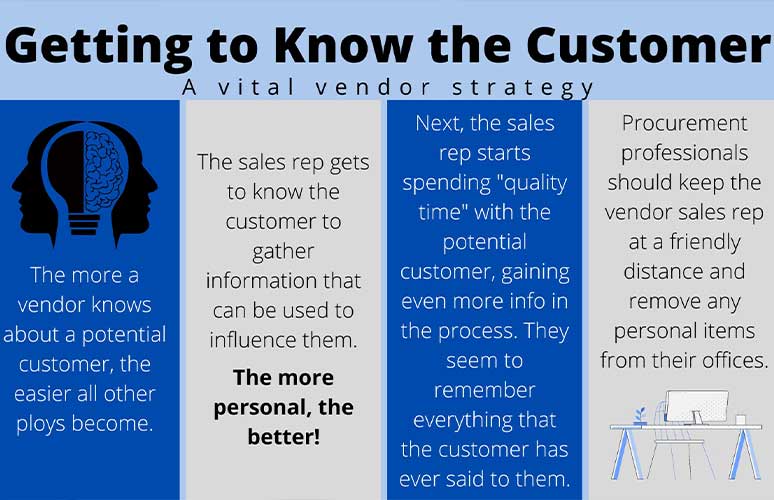
This is a vital telecom procurement strategy for vendors; without the information they obtain by getting to know the customer, all of the other ploys become much more difficult to implement. Of course, the more they know about the customer, the easier all other vendor negotiation tricks become. Thus this ploy is both extremely common and highly effective.
The gist of this telecom procurement strategy is that the vendor gets to know you in order to gather advantageous information that it can use to influence you. The more personal this information is, the better. The vendor sales rep utilizes this information to make themselves as appealing as possible and essentially befriend you (or, at least, that’s how it seems on the receiving end; this type of “friendship” is not a true friendship, but a manipulative ploy).
Sales reps will begin spending “quality time” with you, scheduling events that they know you will enjoy. For example, if they notice a photo of you with your bowling league on your desk, the vendor will absolutely take you bowling. During this quality time at the bowling alley, the vendor will ask multiple leading questions to gain even more information.
Not only do vendors carefully look around potential customers’ offices to glean as much information as possible, but they also take a good look at the whiteboard. It surprises many people just how much valuable information vendor sales reps can find there!
As crazy as it may sound, vendors are trained to take highly detailed notes regarding every interaction they have with a potential customer. They note every little detail and store it away for future use.
It’s simple to understand why this telecom procurement strategy is so effective. People are generally quite flattered when others pay this type of attention to them. They feel special when the vendor seems to remember every little thing they’ve said in the past. As a result of this flattery, they tend to talk far too much and reveal information they shouldn’t. In addition, vendors utilize silence and uncomfortable pauses in the conversation to encourage potential customers to open up even more.
Spotting this vendor ploy is pretty easy for the most part. The vendor sales rep will be extremely inquisitive, highly attentive, and overly interested in everything you have to say. They’ll pay fantastic attention to personal details in particular. And they will want to take you to various places and take part in activities that relate to your interests. If you attend, you’ll notice that large amounts of alcohol are always readily available.
Resisting this ploy mainly consists of keeping vendors at a friendly distance. In some cases, it may be necessary to use silence and long pauses to get the vendor to speak rather than potentially giving away information you shouldn’t.
It should go without saying that no matter how well you believe you can handle your liquor, you should never drink alcohol with the vendor. In addition, it’s wise to remove any items from your office that could give the vendor insight and personal information to use against you.
Erasing the whiteboard is also vital, although one fun tactic is to write the vendor’s competitors’ names and some random numbers on the whiteboard and lightly erase them so that the figures are just barely visible if the vendor sales rep looks carefully. This is sure to throw the vendor for a loop!
Another way to get under the vendor’s skin is to display a competitor’s promotional items or even wear a shirt with the competitor’s logo on it. This will push the sales rep even harder to offer a good deal because it’s clear to them that they have competition.
15. Obscuring Problems with Misdirection and Redirection

This vendor telecom procurement strategy typically occurs in group settings, such as a meeting between vendor reps and your procurement team, or a vendor demonstration.
During this type of meeting, you or a team member ask a question or attempt to get the vendor to address a concern. In response, the vendor tries to misdirect you, your attention, or your line of discussion. This enables the vendor to gloss over the issue or disguise a shortcoming. The goal here is for the vendor to allow you, as a potential customer, to see and hear only the things it wants you to see and hear.
This ploy is much more subtle than some of the others. Vendors can employ it in several different ways. They might use silence, incomplete facts, and misleading statements to misdirect or redirect your procurement team. Sales reps might make excuses, skirt questions, and lack detail in their responses. Generally, the vendor will avoid giving straight answers and will instead offer up incomplete ones.
This ploy works very similarly to a magician’s smoke and mirrors. The vendor attempts to redirect your focus and attention by distracting you with something else. While you can’t force vendors not to use this type of telecom procurement strategies, you can utilize handy counter-tactics.
The first is to stay focused and persistent while requiring specific, straightforward answers to any questions asked. Avoid getting distracted and return the conversation to the question or concern at hand.
Another method of countering this vendor ploy occurs when meetings are being planned. To maintain leverage and power, your team should give specific instructions to the vendor regarding how many representatives can attend the meeting or demonstration.
If more vendors show up than the number that was established, your team needs to stick to the rule it put in place and only allow that specified number of reps into the meeting room. In addition, your team should ensure that it outnumbers the vendor reps. This will make it easier to require straight answers from the vendor and redirect any attempts at misdirection back to the question or comment at hand.
16. Impressing the Client
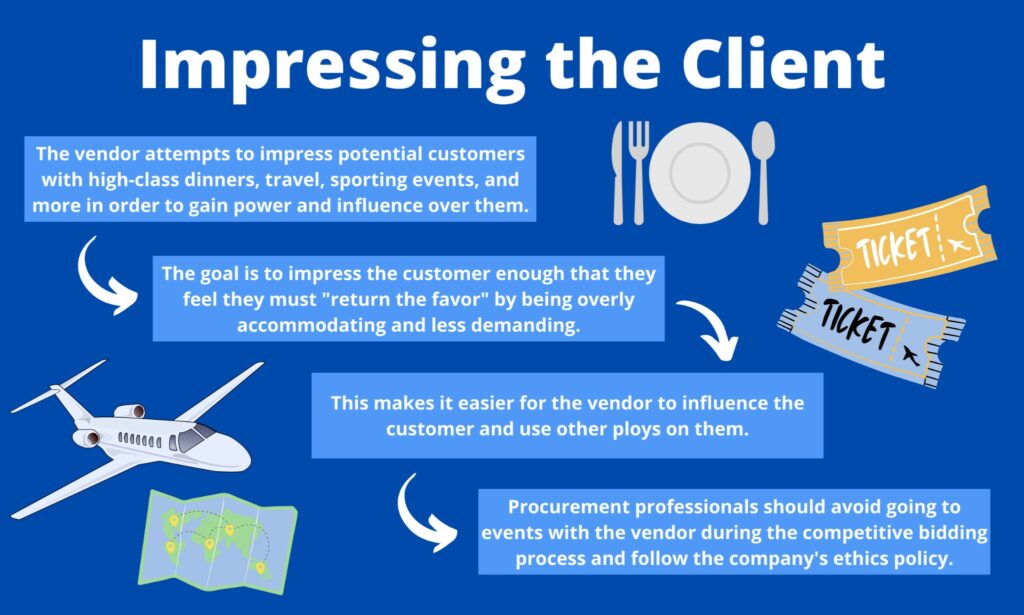
A well-known ploy used by vendors in all industries is impressing the client. This telecom procurement strategy is pretty self-explanatory: The vendor attempts to impress or awe potential customers in order to gain power and influence over them.
The train of thought is that once you’ve been sufficiently impressed, you’ll feel obligated to essentially “return the favor” to the vendor. You’ll feel ingratiated and thus behave in a more accommodating, less demanding manner. It will then become easier for the vendor to influence you and use other ploys. If you or your team members allow yourselves to be sucked in by the vendor, it’s easy to get carried away, and the vendor’s strategy becomes highly effective.
This telecom procurement strategy isn’t subtle in the slightest. It includes invitations to impressive affairs, such as high-class dinners, shows, travel, and sporting events. There will also be expensive wine, limos, first-class flights, and opulent suites.
It’s easy to see why this ploy works well; once someone gets a taste of the so-called “high life,” they tend to want more. Even if it’s not for them, they’re still likely to feel indebted or obligated to the vendor for providing such an impressive experience.
While socializing and going to lunches and dinners with the vendor is appropriate at some times, you should avoid it altogether during the competitive bidding process. To counter this tactic, politely decline vendor invitations to these events, following both your personal code of ethics and your company’s ethics policy.
17. Mirroring Potential Customers

Mirroring the customer is one of the most critically important ploys for vendors. Once a vendor has compiled enough information on a potential customer by getting to know them, they tend to stereotype them into a particular personality type to frame their interactions and communications. The vendor sales rep may go so far as to change their pitch, tone, and overall style of speaking to appeal to the customer as much as possible.
You can spot this vendor telecom procurement strategy in a few different ways. First, the vendor will be very inquisitive for some time and then will seem to change to become more similar to you. The vendor rep may even appear to be a “clone” of you in the ways that they speak and dress.
In some cases, the first vendor rep that works with you may be suddenly replaced by another who just so happens to have an inordinate amount of things in common with you.
This is an effective vendor ploy because of the concept of homogeneity, which, put into simple terms, is a way of saying that birds of a feather flock together. People like to surround themselves with similar people, and the vendor is using this concept to its benefit.
Awareness goes a long way in countering this ploy. Holding the vendor accountable and being forward and direct in communication is effective. Know that the vendor rep is essentially being manipulative and changing their personality, style, and even their voice to appeal to you. This can help you see the situation for what it is, rather than being swayed by the seemingly personal connection between yourself and the vendor.
Technology Procurement Group can provide expert guidance to your procurement team throughout the negotiation process. Call us at 1-888-449-1580, email us at info@TPG-llc.com, or fill out the short form at the bottom of the page for more information.
18. Requiring Immediate Action
Another telecom procurement strategy that vendors often use is to require immediate action from the procurement team.
As Stephen Guth, author of The Contract Negotiation Handbook, explains, “Unless the vendor is in control of the relationship, it’s a proven statistic that the longer you take to make a purchasing decision, the less likely the vendor will be able to maximize its profit, limit its commitment, and minimize its risk. When it comes to making purchases, time is one of your best negotiation tactics (and one of a vendor’s best ploys).”
There are a few reasons why vendors try to make you speed up the negotiation process. One important reason is that the vendor doesn’t want its potential customers to have enough time to check out its competitors’ prices and find a better deal elsewhere.
Another is that the more time your procurement team has to research and analyze the vendor’s products and services, the more likely it is that your team will discover various flaws and drawbacks. This can lead to your team requesting concessions or going with a different vendor altogether.
A final reason the sales rep may use this ploy is that they want to meet deadlines for SPIFs, which are sales promotion incentive funds. Having a lot of money on the line is a highly effective motivator that leads vendor sales reps to push to get the deal done as soon as possible.
The strategy of requiring immediate action from procurement teams is not a subtle one. The vendor will very overtly attempt to push your team to agree to the deal. You may hear the sales rep say things like, “If the deal isn’t done by (a certain date), you’ll have to pay more.”
It’s simple enough to understand why this vendor ploy works. Vendors know that deadlines create pressure and that procurement professionals are already working with plenty of deadlines.

Time pressure creates a lot of stress, and stress can sometimes lead teams to agree to deals that aren’t as favorable as they should be. Therefore, the vendor sales rep strategically adds more deadlines, and thus more pressure, to potentially impair your procurement team’s decision-making skills.
Suppose you believe that waiting will result in you losing out on a great deal. In that case, you’re much more likely to forgo additional negotiations in favor of securing what you believe to be better pricing. In reality, however, there is rarely anything that prevents a vendor from being able to offer the same pricing after a specific date. Unfortunately, this is a form of bluffing that is far too effective.
As with most vendor ploys, prevention is a good counter. In this case, prevention entails preventing the vendor from being aware of your company’s important dates and deadlines. Staying cool, calm, and collected throughout the process, regardless of what the vendor says about limited-time pricing and related matters, is also vital to keep this tactic from working in the vendor’s favor.
Aside from remaining calm, slowing down communication with the vendor and appearing indecisive can motivate the sales rep to offer up a better deal because they think they may lose you as a potential customer. If your procurement team becomes difficult for the vendor’s sales reps to get a hold of, the vendor may begin to panic and think they have lost the deal–and offer a better one as a result.
What can you do in the moment when a vendor sales rep is applying time pressure? You can go on the offensive. You can shrug off the vendor’s threats and say, “I guess we’ll just have to wait and see what happens.” You can also suggest, “It looks like we’ll have to find a vendor that can hold their price then.” (Of course, it’s important to be working with more than one vendor until the contract is signed.)
Your procurement team can also use the vendor’s time pressure tactics as leverage, saying something along the lines of, “We might be able to get the deal done by the date you mentioned, but we’ll need some additional concessions.” This enables your team to adjust the contract to be more favorable.
Your team can even say, “If you can sign our contract template right now, we can close the deal today,” turning the time pressure around on the vendor and pushing it to agree to a contract that isn’t as favorable for it.
19. Providing Flashy Resources
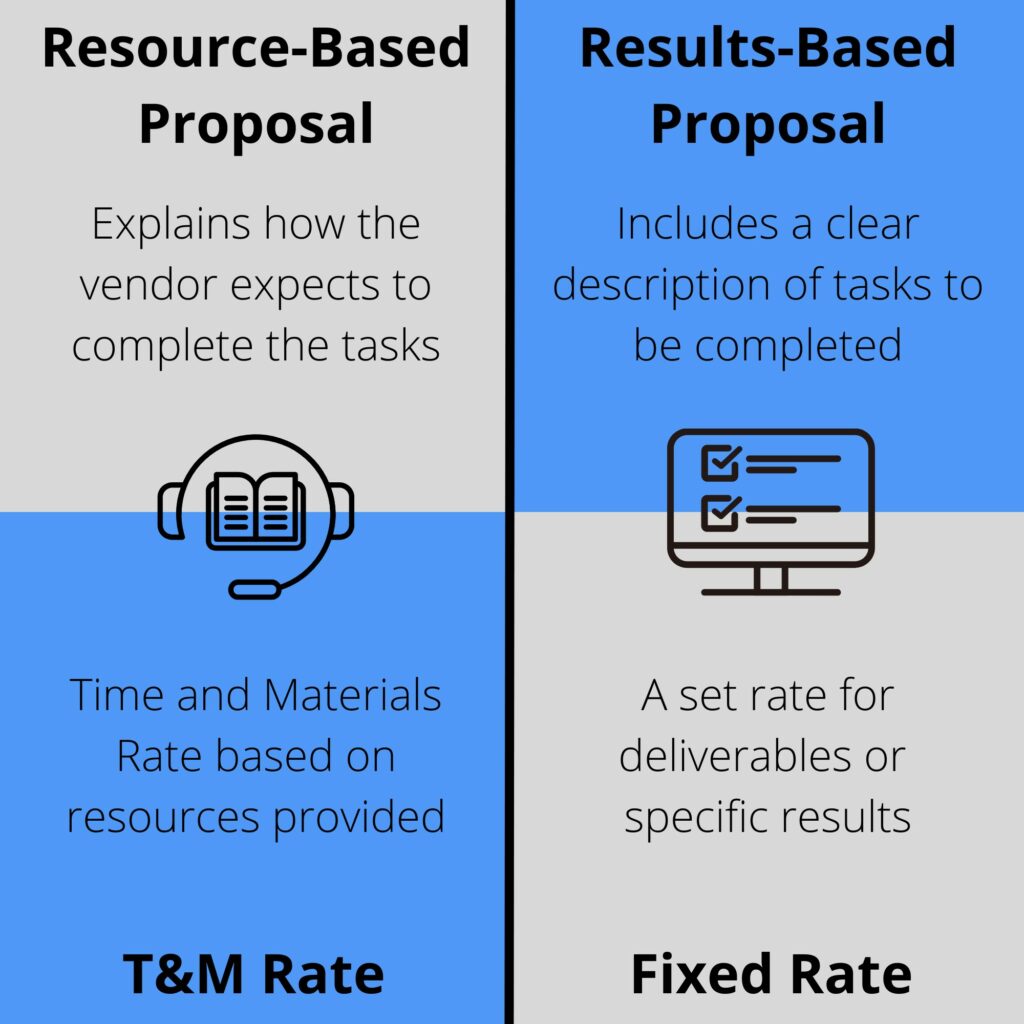
For this ploy, the vendor will offer its professional services for a set period of time. They’ll offer to take on the work requested of you as the potential customer, and they’ll provide sophisticated charts meant to impress with detailed information and graphics regarding hours, duties, staff resources, titles, and more.
Although this may seem very generous of the vendor, the issue is that, in reality, the vendor is hoping that everything takes longer than the proposal specifies. It will use a T&M rate, or Time and Materials rate, based on resources provided rather than results obtained. If things work in the vendor’s favor and take longer than expected, the vendor will earn additional revenue. The vendor may even drag things out on purpose to get as much money out of your company as possible.
There’s an important distinction between a resource-based proposal or statement of work (which uses a T&M rate) and a results-based proposal or statement of work. A resource-based proposal details how the vendor expects to accomplish the tasks. It may sound great, but in the end, the vendor takes no responsibility for the outcome of the tasks. Instead, you, as the customer, are responsible for the results.
Meanwhile, a results-based proposal includes a clear description of the tasks to be completed, specifying the deliverables. It lists the required outcomes and results. With this type of proposal, there’s much more accountability for the vendor. Sometimes, a results-based proposal is also called a “fixed-price” proposal. It’s not uncommon for vendors to claim that they never work with fixed-price proposals. However, accepting a resource-based proposal puts your company’s procurement team at a disadvantage.
It’s simple to spot this vendor’s telecom procurement strategy as long as your procurement team knows what it’s looking for. Anytime the vendor sales rep suggests a proposal with payment based on hours or days rather than deliverables or results, they’re attempting to get more money out of your company than is necessary.
Many companies fall for this ploy because of the awe-inducing charts and visuals the vendor provides. Flashy charts can easily instill confidence and reinforce the idea that the vendor knows exactly what it is doing and can provide your company with the professional services it needs. Once you’re sufficiently impressed, you’ll pay less attention to the type of proposal (resource-based versus results-based).
How can procurement teams counter this vendor ploy? Education is essential, of course. Your team must be aware that it wants results at the end of the day, not resources. In addition, clarifying your company’s wants and needs is essential. Your team must establish clear responsibilities, milestones, and deliverables for the vendor.
A good results-based proposal contains several key elements. The first is clearly-defined goals. Technical and schedule requirements explained in terms of desired results are also essential. There should be set methods of performance measurement to keep the vendor on track. Finally, the proposal must include established requirements, including milestones and deliverables.
20. Using the Excuse of Setting a Precedent

When potential customers ask that a vendor customize something for them or otherwise have a special request, it’s common for the vendor to respond by saying, “Oh, we can’t do that. That would set a precedent.” This sounds very official and hard to challenge; after all, your procurement team doesn’t know all the details of the vendor’s company rules, so it’s inclined to accept this response.
Your team is even more likely to accept the vendor’s words at face value if the sales rep continues to say things like, “This has always been the price,” or “This has been our policy historically.”
The vendor may even say, “Changing this for you would mean we now have to go back and give all of our customers the same discount.” Anytime a vendor mentions setting a precedent or says that it’s company policy that the vendor doesn’t, can’t, and won’t fulfill a request, this ploy is in use. Vendors most frequently utilize this telecom procurement strategies in the middle of negotiations as a defensive measure that protects them from making unwanted concessions.
Your procurement team can counter by asking the vendor more specifically about the policy. You might ask, “Do you really have to allow other customers the same concession? Why do you have to do that?” Another good question for the vendor is, “Do you really keep track of previously set precedents?” Of course, if the vendor says that it does, it’s only fair to ask why it won’t set a precedent again since it has admitted to making exceptions in the past.
The goal of asking these questions is to listen for inconsistencies and details that give away information about the vendor’s policies regarding precedents. Often, this line of questioning will throw the vendor sales rep off track and cause them to trip up. When this happens, the rep often becomes frustrated enough to make the desired concession rather than attempting to maintain the facade.
21. Bracketing

Bracketing is a tricky vendor telecom procurement strategy because it doesn’t happen at one specific time. When employing bracketing, the vendor’s goal is to figure out a potential customer’s upper and lower budget brackets.
In other words, the vendor wants to determine the company’s range, from what it wants to pay (the lower bracket) to what it is willing to pay at the most (the upper bracket). Any question or comment the vendor makes mentioning specific dollar amounts may be an attempt to determine your upper and lower brackets. Once the vendor figures this out, its new goal is to work you to the top end of your range, getting as much money as possible from you.
This vendor ploy is particularly powerful because it’s often quite challenging to spot in the moment. It’s usually completed through many seemingly insignificant interactions, rather than taking place during one specific incident.
Many procurement professionals and others looking to work with vendors fall for the bracketing ploy without even realizing it; they unintentionally offer too much information during conversations with the vendor. This could be as innocuous as nodding or saying something vaguely affirmative when the vendor mentions the cost of a product or service.
Here’s one example: You and a vendor sales rep are having a discussion, and the vendor makes what seems to be an offhand remark about one of its competitors. “I’ve heard that they charge at least $150 per hour for this service but don’t do a very good job.”
Later on (this could be hours or days in the future), the vendor remarks, “We might be able to provide the same service as our competitor for $200 per hour, but we’ll have to negotiate to determine how we can keep the quality high at such a low price.” You nod and say, “We can discuss that.”
The vendor sales rep now knows it can get at least $150 per hour from you for the service they discussed. The $150 now serves as your lower bracket. Since you gave an affirmative response when the rep mentioned the $200 per hour price, it knows it can potentially get $200 per hour from you. This is now your upper bracket in the vendor’s mind. The thing to note here is that the vendor may have been able to offer this particular service for $100 per hour or even less. But because of the way you responded when the rep mentioned different prices, it knew it could get more money for the services. Your responses probably seem pretty insignificant, but vendor sales reps are highly skilled at bracketing in this way.
Another example of bracketing involves the vendor saying something along the lines of, “If you tell me what (a specific competitor’s) price is, then I can try to match it.” Well, if you go ahead and share the details of the competitor’s pricing, you may be breaching your company’s code of ethics and a confidentiality agreement. You may also be throwing away your chance of getting a lower price because you implied that you’d at least be willing to pay the competitor’s price.
A vendor may also say, “I know you’re paying $200 per hour for this particular service.” If you respond by saying, “No, I’m actually paying $100,” you’ve just told the vendor your lower bracket amount.
Clearly, this ploy can be pretty tricky! So what is the best way to combat it?
One way is to only offer noncommittal responses void of any real information. Another is to answer any financial questions from the vendor with additional questions. But perhaps the best way to respond to the bracketing ploy is to offer the vendor disinformation, leading them to believe that your company’s range is much lower than it is in reality. This obviously requires you to be knowledgeable and aware of the bracketing ploy when it is happening. Still, if you can achieve it, you’ll score a much better deal.
22. Posing as the Only Solution

Yet another common vendor ploy is what’s sometimes referred to as “the only game in town,” which is when the vendor acts as if it’s the only one that can provide the products and services your company needs.
Inexperienced procurement professionals may fall for this ploy and become afraid to upset the vendor because they believe it’s their only option. Thus they must be agreeable and not request too many concessions. Otherwise, they could lose out on their only opportunity to fulfill the company’s needs (or so they believe)!
In reality, this ploy only works on those who aren’t yet negotiation-savvy, and it plays on their emotions. It’s just not realistic that a vendor would be the only one to offer the necessary products and services.
In the telecom industry, you’ll often find that there are very few differences between vendors, and therefore, there are plenty of options available. When procurement professionals fall for this ploy, they look quite foolish to the vendor, and they set themselves up to be taken advantage of, both for the current contract and in the future.
The best way to counter this ploy is not to fall for it in the first place. Your procurement team must be educated about various vendor ploys and the reality of negotiations. Again, it’s key to pre-negotiate the deal with two vendors until it’s time to award the contract to one of them officially. This way, there’s always a concrete backup plan in case one of the vendors proves itself unsuitable.
Another way to counter this is to include your company’s contract template with the RFP and require vendors to respond to the template. Then, adding vendors’ contract reviews as part of the RFP evaluation criteria can help to ensure that your company settles on a vendor that will agree to a favorable contract.
Procurement teams should include termination assistance services provisions in significant contracts as well. This type of provision requires the current vendor to help your company transition the services it’s providing to a replacement vendor. Not only does this remind the vendor that your company can terminate, but if your company needs to do so, it’s not as difficult to transition to a new vendor.
23. Citing a GSA Violation
Vendors don’t use this ploy as frequently as they did in the past (most notably in the 1990s), but it’s still worth mentioning. Generally, the way it goes is that you request a price concession, and the vendor responds, “We can’t do that. That would violate our contract with the government’s General Services Administration.”
Spotting this vendor’s telecom procurement strategies is simple. Any mention of the GSA schedule or a pricing contract with the federal government should tell you that this ploy is being used.
This ploy works (or used to work in the ‘90s) because it sounds official. The best way to counter it is to display knowledge of GSA. The most important thing to note is that the vendor can absolutely offer lower prices as long as the deal is structured differently. Saying something like, “I’m aware that GSA does not apply here since my deal structure differs from the GSA schedule, so let’s move on,” should work perfectly.
24. Citing an SOX Violation
This ploy is very similar to the GSA violation telecom procurement strategy mentioned above, but SOX is a more modern variation. It refers to the Sarbanes-Oxley Act of 2002, or SOX, which establishes standards for all United States public accounting firms as well as public company boards and management. However, it does not apply to privately-held companies.
SOX was enacted due to a series of corporate and accounting scandals that cost investors billions of dollars. This act was meant to restore trust in securities markets and prevent companies from publishing false financial information. In short, SOX details how companies can collect, verify, audit, and report financial information. However, SOX has absolutely nothing to do with concessions that companies can and cannot make.
You’ll easily be able to recognize this ploy based on the mention of SOX. Since it sounds very official and many people have no clue what it is or means, vendors often get away with using it. The best way to counter it is for your team to educate themselves on what SOX actually deals with. Then, your team can simply let the vendor know that they have a solid understanding of SOX.
It’s also important to note that if the vendor is a privately-held company, SOX doesn’t apply to it at all. If it’s a publicly-held company, SOX only influences how it handles financial information, but not its pricing or any concessions.
Saying things like, “Where in SOX does it say that?” and “Show me which section of AICPA’s SOPs you’re referring to” should stop the vendor sales rep in their tracks. Otherwise, it is also effective to ask to speak to the vendor’s accounting department or to inform the vendor sales rep that their revenue recognition issues aren’t your company’s problem.
25. Problematic Evaluations

You’ll frequently see this vendor strategy when working with equipment vendors. Basically, the vendor will offer you an evaluation unit for trial purposes and attempt to immediately convince you to sign the agreement.
The goal here is to get you to fall in love with the product and give up your leverage so that you pay more than you need to. It’s very similar to taking a test drive at a car dealership. Once a person takes the product for a spin and imagines how it could change their life, they’re sold.
Software vendors don’t often use this telecom procurement strategy, however. This is because when potential customers complete an evaluation or trial, they tend to notice various bugs and issues with the software rather than falling head over heels for it.
The key is to pre-negotiate with the vendor if an evaluation is necessary. Including a provision that talks about unexecuted purchase agreements is very helpful here. This provision should state that your company gets 30 days to inform the vendor of whether or not it will be purchasing the product, and that your company has no obligation to explain to the vendor why or how it came to that decision.
Another vital provision has to do with the failure of the equipment. It should state that the vendor will extend the trial period by the time it takes to remedy the failure and provide maintenance and support at no charge to the customer.
26. Sending Contracts as PDFs
A vendor ploy that may seem like a simple mistake is sending over a contract as a PDF. You’ll most often see this when working with newer or non-strategic vendor sales reps and contract professionals. The problem with receiving a contract as a PDF is that it’s an unchangeable format, so it’s not exactly conducive to redlining. This slows down the process and makes things more difficult.
The way to respond to this is for your procurement team to send the vendor another copy of your contract template and let them know how unprofessional it was to send a PDF.
Then, demand that the vendor send the contract in an editable format. If the vendor refuses to do so, it’s time to use a PDF cracker. (There are plenty available for purchase, and some can even be used for free online.) To really get under the vendor’s skin, you can then send your comments back to the vendor in PDF format.
27. Making Empty Promises
Vendors’ contract language is often full of empty promises. These empty promises use “weasel words” that sound nice but don’t actually commit the vendor to do anything. For example, the vendor may promise to “attempt to help Customer by providing…” which only means that the vendor will try to do something–but it’s not obligated to follow through and actually do it.
If your company is paying the vendor for something, then the vendor should provide it, not just “endeavor” or “make an effort” to do so. Therefore, it’s essential to look out for these weasel words when redlining the contract and replace them with words that indicate commitment. These are words like “agree,” “deliver,” and “guarantee.” Below, find a chart with more examples of both weasel words and words of commitment.
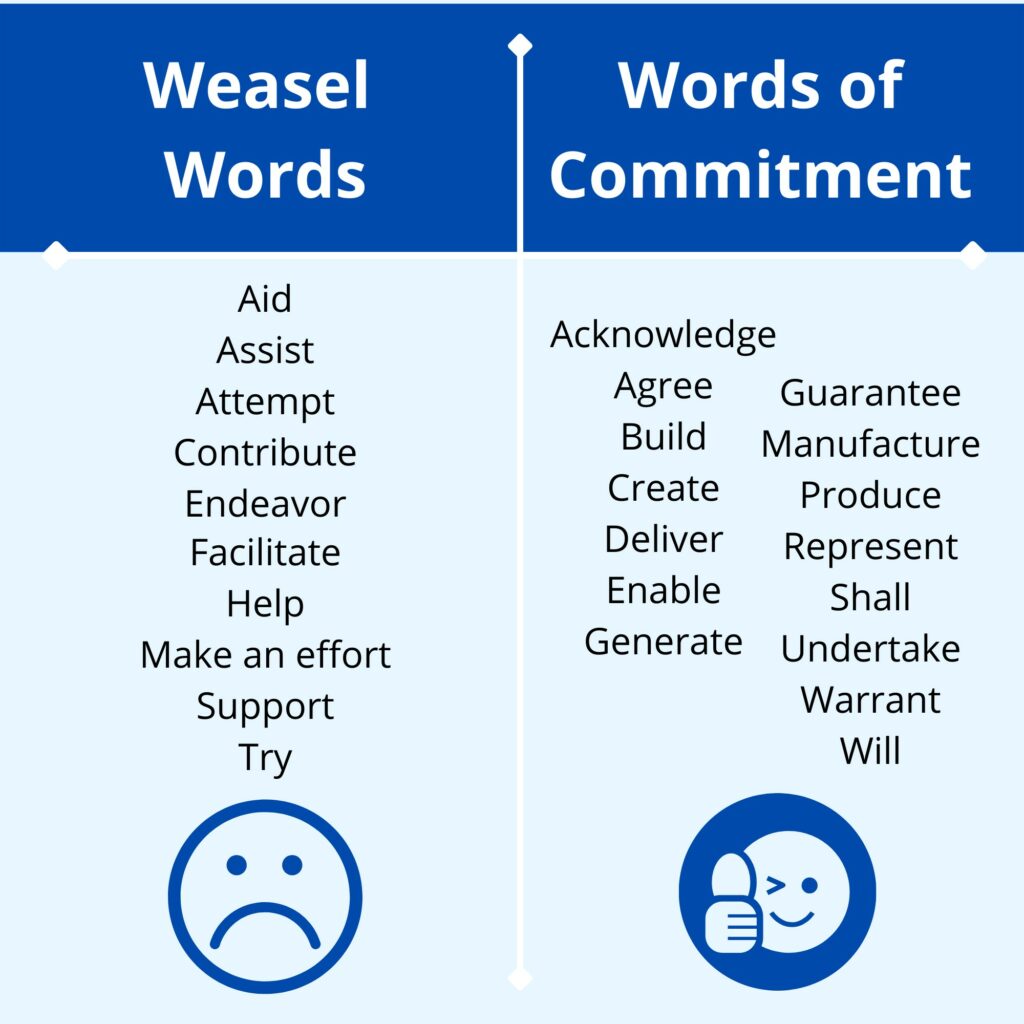
28. Carriers Relying on Relaxation After Signing
A common mistake is assuming that your work is done once the contract is signed. It’s necessary for you to ensure that you’ve actually received everything that you negotiated and to thoroughly analyze the first few bills from the vendor to confirm that it reflects the negotiation and contract.
In many cases, vendors rely on the companies they’re working with drop their guard after signing the contract, and they may try to shortchange your company or fail to deliver on everything that was negotiated.
Simplify Negotiations with Technology Procurement Group

If identifying and countering vendor ploys isn’t your area of expertise, working with TPG is a terrific way to ensure that your company gets everything it needs out of telecom negotiations. Our professionals are here to help you achieve business objectives and benefit from cost savings.
Not only do we offer telecom procurement strategy consulting and IT procurement services, but we also provide telecom and wireless expense management, RFP management, wireless expense reduction, and telecom contract negotiation.
Ready to work with us, or interested in getting more information? Call us at 1-888-449-1580, email us at info@TPG-llc.com, or fill out the simple form at the bottom of the page. We look forward to helping you optimize your procurement process!




